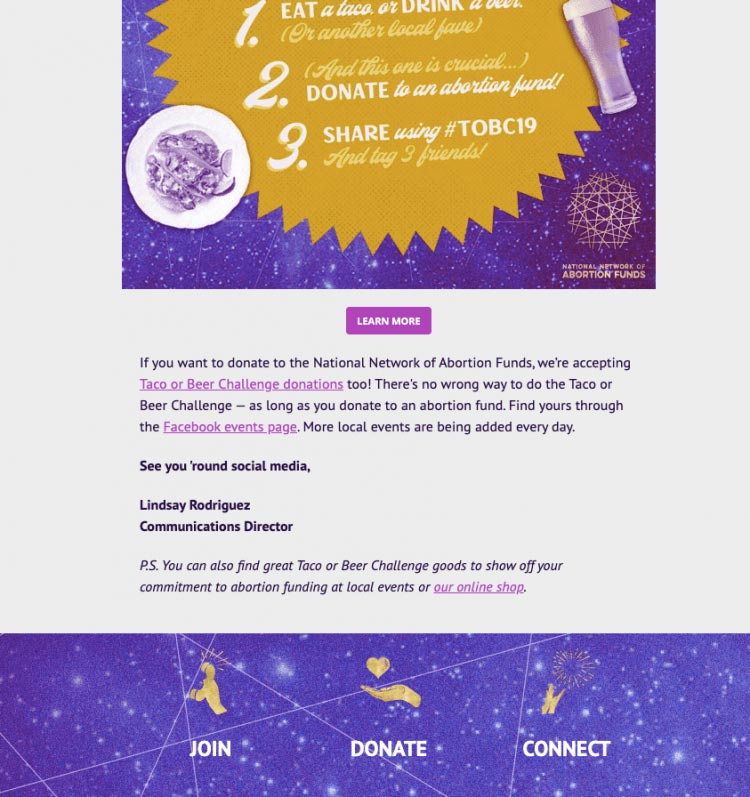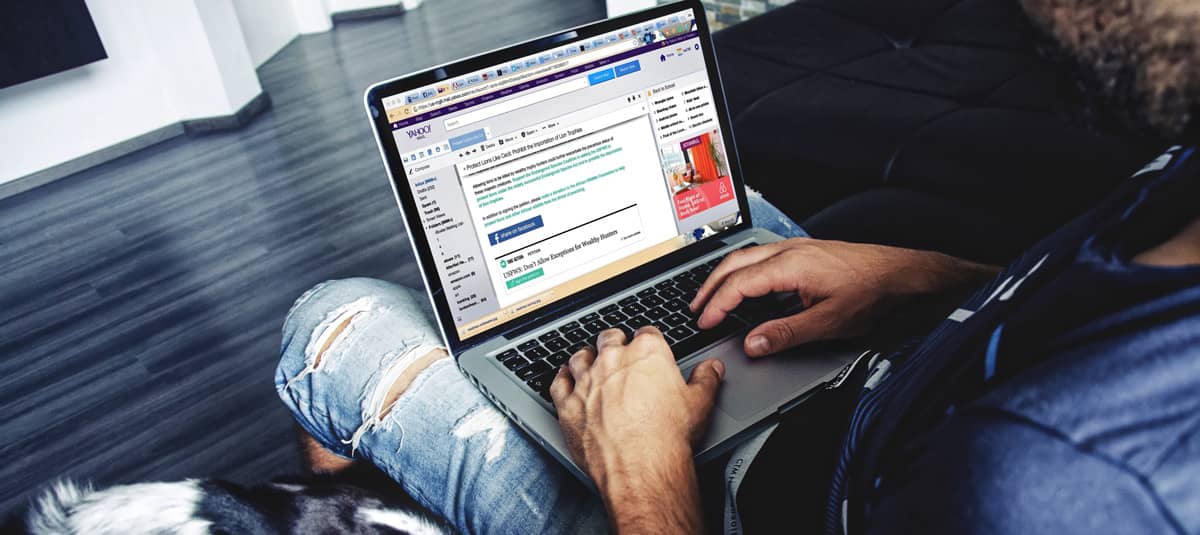11 Tips to Increase Your Email Click-Through Rates

Request a Demo
Learn how top nonprofits use Classy to power their fundraising.
Your email click-through rate (CTR) tells you whether people engage with your emails and land on the pages you want them to see or abandon your message before taking that next step. Increasing your CTR starts with a few best practices, a dash of creativity, and a bit of experimentation for meaningful results.
Here’s why you should care about your email CTR, with 11 tips to boost your click-through rate and engage donors in a more impactful way.
What Is an Email Click-Through Rate?
Your CTR is the percentage of people who opened your email and clicked on a link within the message. A high click-through rate means you’ve successfully enticed your audience to explore your content and take action.
CTR is an essential metric for nonprofit marketers because it helps them better understand their audience. Engaging subject lines, layouts, and visuals translate to higher CTRs, but it’s up to them to experiment and learn what resonates best with their audience.
If you use an email marketing tool, it should showcase your CTR within its reporting metrics. If not, you can also calculate your email CTR manually. Here’s how: take the number of clicks your email received and divide that by the number of people who opened your email. Multiply that number by 100 to show a percentage.
Your CTR can vary depending on the email type and specific audience preferences. If your CTR is lower, now is the time to set a goal to improve it.
How to Increase Email Click-Through Rates
1. Write Compelling Subject Lines
Seasoned nonprofit marketers know that email success starts with the subject line. To engage with your email, readers need to open it first.
Here are a few tips to level up your copywriting:
- Keep it brief. Optimize your language to make the most of the character count limit—about 50 characters or less, including spaces.
- Speak to emotion. Decide what emotion you want your audience to feel when they read your subject line, and craft your message accordingly.
- Use an A/B test. Send the exact same email with two different subject lines. Which one performs better? If your audience ignores questions in subject lines but responds to emojis, that’s a valuable insight for future marketing campaigns.
For more tips, check out this blog to achieve better open rates with killer subject lines.
2. Optimize for Mobile
Classy platform data shows that mobile device traffic makes up 56% of all traffic to donation pages. So if your emails look fantastic on a desktop but are cluttered, incomplete, or difficult to navigate on mobile, you’re losing almost half of your audience.
There’s a simple solution for this: preview your email on mobile. Does your layout incite action, or is it a visual headache? With this level of quality assurance, you ensure your message gets delivered the way you intended, no matter how your reader views it. This concept is also known as responsive design.
Here are a few questions to ask yourself as you look at your email on different devices:
- Are all the links working and pointing to the right places?
- Are the font sizes legible?
- Are our brand colors showing up correctly—or better yet, is the email template designed for accessibility?
- Are the videos and images loading quickly and displaying as intended?
- Are our calls to action (CTAs) clear and easily clickable?
3. Get to the Point
Less is more with email copy. Since most of your audience is reading on their phones, say what you need to say and move on.
If brevity doesn’t come naturally, try a free app like Hemingway Editor or Grammarly to simplify your writing.
Free Download: 13 Donor Retention Email Templates
4. Include a Clear Call to Action
Your email should tell your readers what to do, whether donate to your cause, share a campaign page, or sign up for an event. Here are a few tips to ensure your CTA is clear and effective:
- Keep the text brief and actionable (think “Donate Now” or “Sign Me Up”)
- Include the CTA above the fold (near the top of the email) so it’s one of the first things readers see
- Add a secondary CTA toward the end if you plan to send a longer email
5. Use Buttons
Use buttons with hyperlinks to prevent readers from missing your CTA. Your email marketing service should allow you to include an effective donate button or relevant CTA in the body of your email. This step makes your appeal stand out and easier to click, which is a big plus for readers on smartphones and tablets.
You don’t have to limit your CTA copy to phrases like “Donate Now,” either. Experiment with different copy on your CTA buttons that align with the message you want to send.
In this nonprofit email example, charity: water anticipates the reader will feel confused by an unexpected description of the best holiday gift. So it uses the CTA to echo that emotion with a simple “Huh?” as the button copy. This copy is unique, which can motivate a curious reader to click through.

Most email marketing services allow you to A/B test within the platform, enabling you to experiment with different elements to see what best captures your audience’s attention.
Whether you strictly test for higher open rates or above-average CTR, running A/B tests can provide a wealth of insight into user behavior. Borrow from charity: water’s example and test different variations of the CTA button copy to see if one leads to higher CTRs.
6. Keep It Consistent
From your colors to your voice and tone, your nonprofit has specific branding elements that should be consistent across all channels. Those channels will likely include your website, digital marketing tactics, cost-per-click (CPC) ad copy, campaign landing pages, and emails.
Given that you’re competing for attention in your readers’ crowded inboxes, you want to remain memorable and enable donors to recognize your nonprofit as soon as they receive your email. That means your email colors, font, and voice should also be consistent, from the subject line to the CTA.
Good design also boosts credibility, which is crucial when seeking donations. Brand consistency is one effective way to show your audience that you’re a trustworthy brand. So be consistent across everything, from your search engine optimization (SEO) efforts to your email campaigns to your landing pages.
Free Guide: Design Basics for Nonprofit Professionals
7. Include Video
According to a report published by Forrester, adding videos to your email can increase CTRs by 200% to 300%.¹ Videos are engaging and shareable, helping your brand tell a story.
8. Try Different Layouts
As a rule of thumb, short emails are usually better, but that doesn’t mean you have to stick to one format. Experiment with different layouts to find what works for your message and target audience. Emails tend to break down into two layout types:
- Single-column: Ultra-readable and great for succinct messages with a clear CTA
- Multicolumn: Ideal for emails that include a variety of content, like links to articles and resources
One layout isn’t necessarily better than the other. Instead, it depends on the message you want to send. For example, an event email should lead with the necessary details at a glance, so a single-column format works well here.
A thank-you email, on the other hand, might invite readers to become more involved with your nonprofit’s ecosystem, so a multicolumn format makes more sense. You can use sidebars and CTAs to direct readers to learn more about your mission, sign up to volunteer, or read beneficiary stories.
9. Include a P.S. Section
Here’s an old copywriting secret: people remember the first and last items in a list significantly more than the rest. Known as the serial-position effect, this concept can pay off big in an email.
If you want to incite a specific action, include it at the beginning and end of your email. If a reader is scanning your message, they might miss the first CTA, but if you repeat it as a final P.S., you cover your bases and catch their eye.
The example below from the National Network of Abortion Funds uses a CTA button near the end of the email, numerous hyperlinks in the closing paragraph, and a P.S. section to offer one more way to support the cause.
This example works because it offers so many options for showing support, allowing the donor to choose how they’d like to engage with the nonprofit.

10. Timing Is Everything
Send too many emails, and you’ll end up in the spam folder. Send it at the wrong time, and people might miss your message.
There is no one-size-fits-all approach to email frequency and timing. Instead, here are some best practices:
- Time: Send emails between the prime hours of 10 a.m. and 2 p.m.
- Test: Identify when your readers are most active with an A/B test of your email send times. Do you have higher click-through rates at certain times of the day?
- Frequency: Follow a regular cadence with your emails, though you don’t have to send a specific number every month. That might mean one email a month or a week, depending on your organization’s goals and bandwidth.
According to Litmus, nonprofits send fewer emails than other companies.² In fact, about 60% of nonprofits send four or fewer emails per month.
Survey your subscribers (via email and/or social media) to get a sense of their desired email frequency and what topics they want to see. You’ll gain a better understanding of your readership, plus more content ideas.
11. Test and Retest
One of the best and most frustrating parts about nonprofit marketing is that data will continually change over time. Your email list will grow, your interests (and those of your donors) will change, and how you present your emails will need to adapt.
Support high CTRs by testing everything: subject lines, layouts, content, timing, and design. Doing so will help you learn more about how to make your nonprofit more data-driven using the results of your A/B tests.
Your CTR proves whether you communicated your intended message. That’s why it’s an important metric to keep in mind as you develop your nonprofit’s marketing strategy.
Engage Your Supporters With Classy
These tips to increase your click-through rate aren’t hard-and-fast rules but starting points. Use them to find what works for your audience and fuels your nonprofit’s mission.
However, getting your email recipients to click through your email is just one step. Once donors land on your donation site, it’s time to convert them. Classy helps you build optimized (and mobile-responsive) donation sites to increase your one-time and recurring donations.
Talk to an expert to see how our fundraising platform can help your nonprofit boost donations and drive engagement with your supporters.
Article Sources
- “Video Is No Longer an Accessory for Marketing – Here’s What You Need to Know,” Video, Forbes, last modified December 15, 2016, https://www.forbes.com/sites/ellevate/2016/12/15/video-is-no-longer-a-marketing-accessory/.
- “Industry Spotlight: Email Marketing at Nonprofits.” Email Marketing, Litmus, April 20, 2020, https://www.litmus.com/blog/industry-spotlight-email-marketing-at-nonprofits/.

9 Email Templates for Nonprofit Annual Communication Plan
Subscribe to the Classy Blog
Get the latest fundraising tips, trends, and ideas in your inbox.
Thank you for subscribing
You signed up for emails from Classy
Request a Demo
Learn how top nonprofits use Classy to power their fundraising.
 Explore Classy.org
Explore Classy.org 

